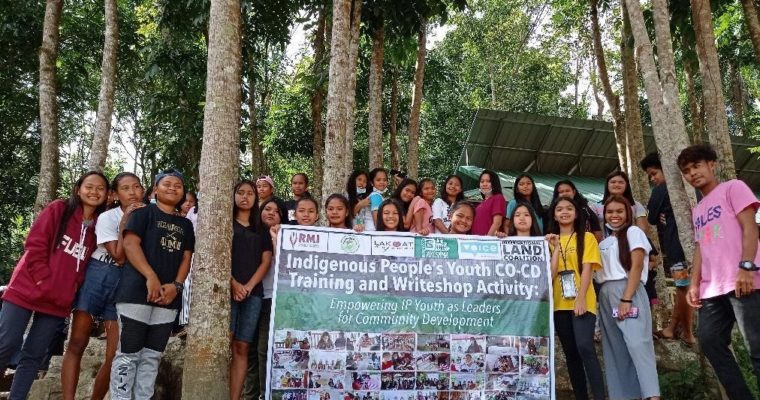In order to help in the development of our indigenous youth as future IP leaders, there is a need to enhance their knowledge in community organizing as a method for empowering others. This enables them to push and advocate for the issues and needs of their community.
Last January 21-22, 2021, PAKISAMA, in partnership with AFA and RMI and with the support of YLA and VOICE conducted a two-day training on Community Organizing for Community Development (CO-CD) training as part of its Being and Becoming Indigenous project. With the theme “Empowering IP Youth as Leaders for Community Development”, the activity was held at the Bangkeruhan Conference Area in Tanay, Rizal, and was participated by 32 IP youth from different sitios (villages) in Barangay Daraitan. The sessions were facilitated by Kelvin Fugaban, community organizer of PAKISAMA.
The first day of the CO-CD training was comprised of lectures on the fundamentals of human rights and community organizing. Workshops were also conducted to further reinforce the learnings that the IP youth have gained from the lectures.
One example of these workshops involved scenario-setting, wherein participants were asked to “introduce” humans to alien visitors. Almost all participants from different groups expressed that humans are full of imperfections such as selfishness, enviousness, unfairness, and dishonesty but there were also groups that focused on humankind’s uniqueness and specialty through our free will, intellect, diversity, virtues, and ability to love.
Other workshops that were done by the participants were:
- A social experiment showing the different levels of privilege experienced by different people in society (police, soldier, governor, indigenous person, accountant, and millionaire). This was done by asking the participant to step forward if they had the privilege mentioned based on their assigned role. The activity showed that all but the IP advanced through the theoretical social ladder due to their occupation, power, and status.
- A story of the small fish versus the big fish wherein the participants processed the story by answering questions about the story. All of the participants agreed that the fear was rooted in the size of the fish and how it consumed small fishes. All of the groups agreed that the organizing efforts of the small fishes reaped great rewards such as saving them from peril and instilling a great sense of unity among them.
- A role-playing activity where participants acted as a city mayor and a community organizer. They were tasked to simulate a scenario where the community organizer is trying to lobby advocacy to the city mayor.
The morning session of the second day of training covered topics on the principles of informal and formal organizations, fundamentals of the processes involved in the formation of an organization, and the formal structure of organizations. The participants were divided into groups and were asked to identify community issues that they think should be addressed and their goals, expectations, action points, person/s responsible, timeline, and resources needed.
Themes Identified by the Participants
| Theme | Goals | Expectations | Action Points | Persons Responsible | Timeline | Resources |
| Forming an organization | A well-established organization | Unity and cooperation, learning, new friends, right to be heard, budget | Seminars Meetings Election Conflict resolution |
IP Youth Partner NGOs and organizers Elders |
Every week/whenever schedule permits | Meeting place, facilitator/s, supplies, funds |
| Education | Help students with online classes | Equal opportunity to learn for everyone | Lobbying | IP Youth, teachers, local leaders | Before the start of class | School supplies, funds |
| Teenage pregnancy | Decreased incidence | Engage all youth, enlighten young people to risks of early pregnancy | Trainings Sex education |
IP youth, health professionals, teachers, parents | January | Meeting place, facilitator/s, supplies, funds |
| Disaster preparedness | To minimize damage from natural calamities | Less damage from floods | Lobbying Awareness-raising Seminars |
IP Youth Local leaders |
Before calamities strike | Announcement systems |
| Limited mobility | Construction of a new bridge | Easier ways to travel | Lobbying Construction |
IP Youth Local leaders Government Laborers |
Summer 2021 | Funds |
A recurrent theme from most of the group presentations was the need to form an organization of IP youth in their area. Other themes that were identified by the groups were: the difficulty they are experiencing with online classes, the incidence of teenage pregnancy in their area, the need for an increase in disaster preparedness, and the limited mobility they are experiencing since their community bridge was damaged due to recent calamities.
At the end of the activity, the participants were able to gain a better understanding of community organizing to empower their fellow IP youth. During the sharing of group presentations, Janna, a participant of the activity, said that “one of our goals is to form a formal organization among us in hopes of helping our fellow youth and form a strong bond among ourselves.”
The CO-CD training contributes to the accomplishment of VOICE, RMI, AFA, LK, and PAKISAMA’s “Being and Becoming Indigenous” project which aims to increase the indigenous youth’s understanding of the position of their cultural identity in the age of modernity.
For related stories, search these hashtags on social media:
#BeingIndigneous
#BecomingIndigenous
#YouthandLandAsia





Comments are closed